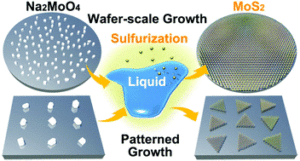
S. Li, Y-C. Lin, X-Y. Liu, Z. Hu, J. Wu, Hideaki Nakajima, Song Liu, Toshiya Okazaki, Wei Chen, Takeo Minari, Yoshiki Sakuma, Kazuhito Tsukagoshi, Kazu Suenaga, Takaaki Taniguchi, Minoru Osada Nanoscale 11 (34), 16122-16129 (2019).
Abstract
Vapor transportation is the core process in growing transition-metal dichalcogenides (TMDCs) by chemical vapor deposition (CVD). One inevitable problem is the spatial inhomogeneity of vapors. The non-stoichiometric supply of transition-metal precursors and chalcogens leads to poor control in the products’ location, morphology, crystallinity, uniformity and batch to batch reproducibility. The vapor–liquid–solid (VLS) growth method often involves molten precursors (e.g., non-volatile Na2MoO4) at growth temperatures higher than their melting points. The liquid Na2MoO4 can precipitate out solid MoS2 monolayers when saturated with sulfur vapor. Taking advantage of the VLS growth, we attained three kinds of important achievements: (i) a 4-inch-wafer-scale uniform growth of MoS2 flakes on SiO2/Si substrates, (ii) a 2-inch-wafer-scale growth of continuous MoS2 film with the grain size exceeding 100 μm on sapphire substrates, and (iii) a patterned (site-controlled) growth of MoS2 flakes and films. We clarified that the VLS growth thus paves a new way for the high-efficient and scalable synthesis of two-dimensional TMDC monolayers.
